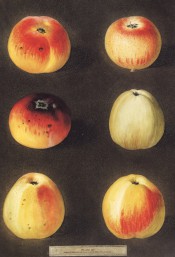Malus domestica ‘Beauty of Kent’
‘Fruit pretty large, three inches and a quarter deep, and three inches and a half in diameter, somewhat irregularly formed, with slightly prominent unequal angles, terminating in the crown, which is rather contracted. Eye small, closed by a short calyx, a little depressed, in a narrow angular basin. Stalk short, slender, rather deeply inserted in a funnel-shaped cavity. Skin a very clear yellowish green, mottled with dull red; but on the sunny side of a bright red, mottled and streaked with yellow, intermixed with russet round the base. Flesh firm, yellowish white, crisp, and tender. Juice abundant, and pleasantly acid. An autumnal dessert apple, from Michaelmas to Christmas.’ [George Lindley – Orchard Guide p.27/1831].
Horticultural & Botanical History
‘A valuable and now well-known culinary apple, in use from October to February. When well grown the Beauty of Kent is perhaps the most magnificent apple in cultivation. Its great size, the beauty of its coloring, the tenderness of the flesh, and profusion of delicate sub-acid juice, constitute it one of our most popular winter apples, for culinary purposes, and one of the most desirable and useful, either for a small garden, or for more extended cultivation.
The tree is a strong and vigorous grower, attains a large size, and is a good bearer; but I have always found it subject to canker when grown on the paradise stock, and in soils which are moist and heavy.
I have not been able to ascertain the time when, or the place where this variety originated. It is first noticed by Forsyth in his Treatise on Fruit Trees, but is not enumerated in any of the nurserymen's catalogues, either of the last, or the early part of the present, century. It was introduced to the Brompton Park Nursery, about the year 1820, and is now as extensively cultivated as most other leading varieties. In America, Downing says, “the fruit in this climate is one of the most magnificent of all apples, frequently measuring sixteen or eighteen inches in circumference.” [Hogg p.33/1851].
Later Hogg wrote ‘This has a good deal of resemblance to the Rambour Franc of the French pomologists.’ [Hogg – The Fruit Manual/1884].
Also figured in Pomona Britannica. ‘A large round apple with yellow skin, heavily streaked with red.’ [PB pl.90/1812]. ‘Beauty of Kent’ is the apple at bottom right.
History at Camden Park
Listed as ‘Beauty of Kent, apple no.67’ in a hand written list of apples in an 1850 catalogue held at Camden Park [CPA]. Most of the plants hand-written in this catalogue subsequently appeared in the 1857 catalogue. That the apples did not is probably an oversight.
Notes
Published Apr 16, 2010 - 05:02 PM | Last updated Jul 24, 2011 - 04:48 PM

Apple ‘Beauty of Kent’ | PB pl.90/1812. Beauty of Kent is the yellow, red-steaked apple at bottom right.
| Family | Rosaceae |
|---|---|
| Category | |
| Region of origin | Garden origin, England |
| Synonyms |
|
| Common Name | Apple, Dessert apple, Keeping apple |
| Name in the Camden Park Record | Beauty of Kent
|
| Confidence level | high |

